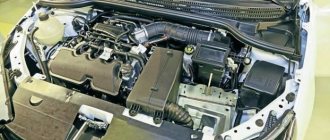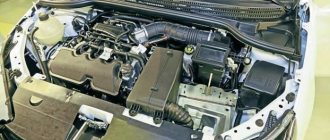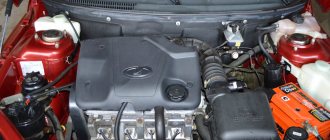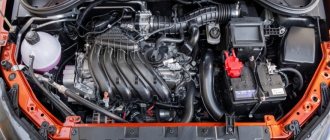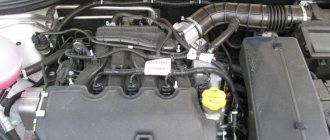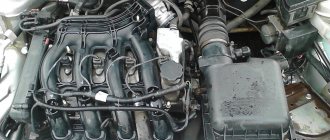Lada Granta engines 8 valves
This power unit was installed only until December 2014, until it gave way to the 11186 internal combustion engine. This is an injection 8-valve engine with a single camshaft, a timing belt drive and without hydraulic compensators, so the thermal valve clearances here will have to be adjusted yourself. Thanks to special holes in the pistons, if the valve belt breaks, it will never bend.
There are plenty of problems with this engine; first of all, owners are bothered by all sorts of noises, knocks, and vibrations. Unreliable electrics, as well as a capricious thermostat, can throw you many unpleasant surprises. Due to poor fuel, valve burnout sometimes occurs here.
Sedan before restyling 2011 - 2019
| 1.6 l 11183 MKP5 | |
| Type | injector |
| Fuel | gasoline AI-92 |
| Location | transverse |
| Cylinders | 4 in a row |
| valves | 8 |
| Working volume | 1596 cm³ |
| Power | 82 hp |
| Torque | 132 Nm |
| Acceleration to 100 km/h | 12.6 s |
| Speed (max) | 165 km/h |
| Ecological Class | Euro 4 |
| Consumption city | 9.7 l |
| Flow track | 6.1 l |
| Mixed flow | 7.4 l |
Similarly, the Motor VAZ website talks about all the details of the internal combustion engine design
This unit is an improved version of the previous one. There is already a lightweight piston with anti-friction inserts, a timing belt from Gates with a service life of 180 thousand km, an electronic throttle valve, a developed cooling jacket and many other improvements, thanks to which it was possible to fit this rather old engine into the strict EURO 4 econorms. Due to the new pistons without holes in the bottom, if the valve belt breaks, it almost always bends. Update: in mid-2022, the manufacturer equipped the unit with plugless pistons.
The list of typical malfunctions of this power unit is quite long. Owners of cars with such an engine regularly encounter burnout of valves due to bad gasoline, overheating, oil leaks, failures of various sensors, and also glitches of the E-gas system.
Sedan before restyling 2011 - 2019
| 1.6 l 11186 manual gearbox5 | 1.6 l 11186 automatic transmission4 | |
| Type | injector | injector |
| Fuel | gasoline AI-92 | gasoline AI-92 |
| Location | transverse | transverse |
| Cylinders | 4 in a row | 4 in a row |
| valves | 8 | 8 |
| Working volume | 1596 cm³ | 1596 cm³ |
| Power | 87 hp | 87 hp |
| Torque | 140 Nm | 140 Nm |
| Acceleration to 100 km/h | 12.2 s | 14.2 s |
| Speed (max) | 167 km/h | 160 km/h |
| Ecological Class | Euro 4 | Euro 4 |
| Consumption city | 9.0 l | 10.4 l |
| Flow track | 5.8 l | 6.1 l |
| Mixed flow | 6.6 l | 7.7 l |
The technical features of the engine are described in an article in Za Rulem magazine
Lada Granta engines 16 valves
This engine is also equipped with a lightweight piston group manufactured by Federal Mogul and a belt with an automatic tensioner from Gates. It is distinguished by a 16-valve head with a pair of camshafts and hydraulic compensators, due to which its power is significantly higher.
All the problems of its predecessors apply to this unit in full. The engine often suffers from lubricant leaks, tripping, floating speed, sensor glitches and valve burnout. Plus, you can add hydraulic compensators that are very demanding on oil quality.
Hatchback before restyling 2015 - 2019
| 1.6 l 21126 MKP5 | 1.6 l 21126 automatic transmission4 | |
| Type | injector | injector |
| Fuel | gasoline AI-92 | gasoline AI-92 |
| Location | transverse | transverse |
| Cylinders | 4 in a row | 4 in a row |
| valves | 16 | 16 |
| Working volume | 1596 cm³ | 1596 cm³ |
| Power | 98 hp | 98 hp |
| Torque | 145 Nm | 145 Nm |
| Acceleration to 100 km/h | 11.2 s | 13.3 s |
| Speed (max) | 182 km/h | 173 km/h |
| Ecological Class | Euro 5 | Euro 5 |
| Consumption city | 8.8 l | 9.9 l |
| Flow track | 5.6 l | 6.1 l |
| Mixed flow | 6.8 l | 7.2 l |
All technical characteristics of the engine are described on the Motor VAZ portal
The updated engine received an adjustable intake tract with dampers in the receiver channels. Also here, the mass air flow sensor gave way to a combination of absolute pressure and air temperature sensors, thanks to which the frequent problem of floating speed at idle has finally gone away.
The reliability of the new unit has increased, although it is not flawless. The thermostat also often fails, the injectors become clogged, and the ignition system malfunctions. But the main threat is the water pump, because of the wedge of which the timing belt breaks and the pistons meet the valves. Update: In July 2022, the manufacturer equipped this engine with plugless pistons.
Hatchback before restyling 2015 - 2019
| 1.6 l 21127 MKP5 | 1.6 l 21127 AMT5 | |
| Type | injector | injector |
| Fuel | gasoline AI-92 | gasoline AI-92 |
| Location | transverse | transverse |
| Cylinders | 4 in a row | 4 in a row |
| valves | 16 | 16 |
| Working volume | 1596 cm³ | 1596 cm³ |
| Power | 106 hp | 106 hp |
| Torque | 148 Nm | 148 Nm |
| Acceleration to 100 km/h | 10.9 s | 12.3 s |
| Speed (max) | 183 km/h | 180 km/h |
| Ecological Class | Euro 5 | Euro 5 |
| Consumption city | 8.6 l | 9.0 l |
| Flow track | 5.6 l | 5.2 l |
| Mixed flow | 6.5 l | 6.5 l |
All differences from its predecessors are described in one of the blogs on Drive 2
Source
Signs of the need for internal combustion engine repair
The reasons why the operation of the engine is disrupted are arranged in a small list, starting with refusal to start and ending with floating idle speed (this problem was removed on the 127 “engine”). Not all breakdowns end in capital damage - sometimes it’s enough to add oil, sometimes it’s enough to adjust the ECU settings.
Compression reduction
A decrease in cylinder compression below 16 atmospheres is a bad sign. Such a high limit corresponds to a compression ratio of 11.
If the compression decreases (or vice versa increases), then the “engine” will have to be rebuilt.
Knocks in the engine
Engine knocks can come from several points. These could be hydraulic compressors, timing belt rollers or pins. The knocking noise could also be caused by low oil level. The answer to the question will be given by a thorough detailed inspection of all parts of the unit and checking the oil level.
Blue smoke from the exhaust pipe
The blue smoke that comes from the exhaust pipe appears when oil enters the combustion chamber. It can leak either from the valves or from under the piston. The result is the same: the oil is eaten up and blue smoke pours out of the chimney. Once the leak is located, half the problem will already be solved.
Troit motor
Sometimes in the cold the engine may stall - don’t be alarmed by this, because it may simply be one of the spark plugs that fails. In this case, we advise you to simply restart the engine and it will stop running.
How much does it cost to overhaul a Priora engine - average price
Self-repair of a Priora engine with 16 valves costs an average of 16-20 thousand rubles. The cost depends on the severity of the breakdown and may be lower or higher than this average range. Repairing a Priora engine can be entrusted to the wrong hands, but then you will have to pay for the work - sometimes the cost of repairs reaches as much as 40 thousand rubles.
This is an unreasonably inflated figure, because, as practice shows, you can rebuild the engine on a Priora, working at a moderate pace, in just three days - and three days of work is definitely not worth that kind of money. Don’t be afraid of not being able to cope - your Lada is easy to repair, and using the advice and “tutorials”, you will conquer even such a task that is impossible at first glance.
Four-cylinder internal combustion engines of the 126 series are installed on Lada Priora cars and their modifications produced by the famous AvtoVAZ company. The 126 engine belongs to the category of four-stroke engines, is equipped with a distributed fuel injection system, the camshaft is located in the upper part. The power unit is equipped with a liquid cooling system. Coolant circulates inside a closed system under pressure. The functioning of the 21126 motor lubrication system is based on splashing and supplying fluid under pressure.
Specifications
| Engine displacement, l | 1.6 |
| Rated power, l. With. (5100 rpm) | 87 |
| Maximum torque, Nm (3800 rpm) | 140 |
| Number of cylinders | 4 |
| Valves per cylinder, pcs. | 2 |
| Total number of valves, pcs. | 8 |
| Cylinder diameter, mm | 82 |
| Piston stroke, mm | 75.6 |
| Compression ratio | 10.5 |
| Fuel supply system | Injector |
| Fuel | Unleaded gasoline AI-95 |
| Fuel consumption, l/100 km (city/highway/mixed) | 8,5/5,7/7,2 |
| Lubrication system | Combined |
| Engine oil | 5W-30, 5W-40, 10W-40, 15W40 |
| Engine oil quantity, l | 3.5 |
| Cooling system | Liquid, closed type |
| Coolant | Using ethylene glycol |
| Motor resource, hour. (manufacturer's data) | 200000 |
The engine was installed on Lada Kalina 2 cars (2004 - 2013); Lada Granta (1.6 l, 8-cl., manual transmission); Lada Priora.
Modifications
The base of the power unit served as the basis for the creation of two popular and fairly well-known modifications. The first was the Sport version Sport 21126-77. One of the most important differences was the increase in power to 120 horsepower and torque to 154 Nm. At the same time, manufacturers managed to raise environmental standards to comply with the Euro 5 standard. The modification was put into production in 2013, and was placed under the hood of Lada Kalina Sport and Lada Granta Sport cars.
NFR 21126-81 is the second, even more powerful modification, which has a power of 136 horsepower and a torque of 148 Nm. To obtain such indicators, manufacturers had to rework the intake manifold and also use camshafts with new cams. In addition, the exhaust system was also redesigned, installing a catalytic collector there. The motor in this version powers the Lada Kalina Sport model.
Description
The Grant engine is a modernized version of the long-produced engines 21124 and 11183. It differs from its predecessors by the presence of a 39% lighter connecting rod and piston group developed by Federal Mogul. For the VAZ-11186 engine it is manufactured directly at AvtoVAZ OJSC.
As a result of the modernization, significantly:
- power increased;
- exhaust toxicity has decreased;
- fuel consumption has decreased.
The cylinder head has become much stronger, since during manufacturing it undergoes a special heat treatment cycle. In addition, it is further strengthened by metal gaskets.
Despite the fact that all the motors in the line are assembled according to an identical design, the 11186 engine has a number of design features. Among them are:
- Improved cooling system for the block and cylinder head. The piston group is covered with a cooling jacket along its entire height and is equipped with piston cooling nozzles, which prevents deformation of the cylinder block due to uneven heating.
- Using a new camshaft drive design equipped with an automatic tensioner.
- The original design of the crankshaft, equipped with special oil channels, which are closed with plugs. This required the use of high-strength cast iron for its manufacture.
A significant drawback of the grant engine is that if the timing belt breaks, the valves bend, which can lead to failure of the power unit as a whole (breakage of pistons and cylinders). In order to protect the engine, a highly reliable drive belt is installed at the manufacturing plant during assembly, which is manufactured by the American company Gates Rubbler Company. The service life of this belt is at least 200 thousand kilometers.
Interesting: As a result of modernizing the VAZ-11186 engine, it became possible to equip it with an electric throttle valve drive (E-gas). This allows you to increase its power to 90 hp. With.
Malfunctions, causes, elimination
Since the 21126 engine is a 16-valve front-wheel drive design with an overhead camshaft position, it is prone to characteristic breakdowns:
| No startup when crankshaft rotates | 1) ignition coils are faulty 2) failure of electronic control 3) DPKV breakdown 4)fuel system malfunction | 1) Repair or replacement 2) flashing or replacing controllers 3) replacing the crankshaft position sensor 4) replacing the pressure regulator, cleaning the fuel module, injectors and ramp |
| The engine won't start | 1) cold 2) warmed up | 1) recharging the battery, cleaning the power system, replacing the coolant temperature sensor, replacing injectors, repairing the fuel management system 2) in addition to the above, replacing the air filter |
| The speed is floating XX | 1) vacuum hose connections 2) cylinder head gasket 3) clogged air filter | 1) replacing or tightening clamps 2)use a new gasket 3) cleaning or replacing the cartridge |
| Misfire in XX mode | 1)low compression 2) injector failure 3) failure of the ignition coils 4) faulty spark plugs | 1) replacing rings; valve stem seals2) installation of new injectors 3)repair or replacement 4) gap adjustment or replacement |
If you follow the requirements of the operating instructions and maintenance regulations, these troubles can be avoided.
Maintenance
Guaranteed operation of the VAZ-11186 engine is ensured by following the manufacturer’s recommendations:
- operating modes;
- timing of maintenance.
Maintenance of the VAZ-11186 engine comes down to:
- Regular inspection of the power unit, as a result of which oil and coolant leaks can be detected. If such defects are identified, they must be eliminated;
- Regular replacement of engine oil - every 15,000 km. It is recommended to use motor oil from well-known manufacturers, purchasing it from trusted suppliers.
Maintenance
To ensure the declared resource, engine 21126 must be maintained in accordance with the regulations below:
- after 10,000 km, change the engine oil with the appropriate filter;
- The battery, attachment belts and crankcase ventilation can withstand 20,000 km;
- The tank cap, antifreeze and cooling system hoses, fuel and air filters cannot overcome the 40,000 mileage mark;
- It is recommended to replace the oxygen sensor after 100,000 km, and the timing belt after 180,000 km.
Complex design solutions have been added to the internal combustion engine, so it is necessary to meet the deadlines for replacing consumables.
Main engines
As the main engines, AvtoVAZ offers customers a choice of the power units already mentioned just above. Let's talk about each of them separately.
VAZ-11186 (VAZ 21116)
VAZ 21116 is another representative of eight-valve engines with 87 hp. under the hood. It is a modified and improved VAZ-21114 engine, which is distinguished by a lower noise level and noticeable fuel economy. They are equipped with Grant's Norma vehicles.
If we compare the VAZ 21116 with the VAZ-21114, we should note a noticeably increased level of environmental friendliness, and the power has also increased significantly. The disadvantages of the engine include a more modest resource than, for example, that of the VAZ-11183. Its pistons are much lighter than those of its predecessor, but this circumstance led to the appearance of two more disadvantages.
So, in lighter pistons there is simply no room left for the recesses, therefore, if the belt breaks, the valves will definitely bend. Another disadvantage of such pistons is related to their fragility. For this reason, pistons can break when colliding with valves, and in four cases out of five such contact will require replacement.
Naturally, potential buyers will also be interested in the dynamic data of this engine. The presence of lighter pistons, which were already mentioned earlier, allowed the engine to increase not only in terms of power, but also in additional efficiency. Cars with such an engine reach speeds of up to 167 km/h, and acceleration from 0 to 100 meters will take them 12.4 seconds.
| Number of cylinders: | 4 |
| Cylinder displacement, l: | 1,597 |
| Compression ratio: | 10,5 |
| Rated engine power at a crankshaft speed of 5600 rpm: | 66 kW.-(90.0 hp) |
| Cylinder diameter, mm: | 82 |
| Piston stroke, mm: | 75,6 |
| Number of valves: | 8 |
| Minimum crankshaft speed, rpm: | 800-850 |
| Maximum torque at 3500 rpm, N*m: | 143 |
| Cylinder operating order: | 1-3-4-2 |
| Octane number of gasoline: | 95(unleaded) |
| Fuel supply system: | Electronically controlled distributed injection. |
| Spark plug: | A17DVRM, BPR6ES(NGK) |
VAZ 11183 (VAZ 21114)
Lada Kalina cars began to be equipped with VAZ 11183 (or VAZ 21114) power units in 2004, and then it was inherited by the Grant “standard”. This is a rather simple and primitive four-cylinder engine with 8 valves, producing 82 hp. and volume 1.6 l.
It cannot boast of solid power characteristics, but it does not cause any special problems when driving, and it is also very easy to maintain. It is distinguished by its environmental friendliness and reliability, while it also has good elasticity characteristics. In addition, this motor is known as one of the most torquey, especially at the bottom.
An important additional plus is a reliable timing system that prevents collisions between pistons and valves when the timing belt breaks.
But during operation of the motor, some disadvantages may be noted, in particular:
- Possible failure to turn the crankshaft with the starter;
- Strong noise when the starter is operating;
- Even after cranking the crankshaft, the engine may not start;
- There is instability when it is idling;
- The engine does not function at full capacity, which causes a loss of continuity. As a result, there are jerks when the car moves;
- The appearance of shots and claps;
- Increased fuel and oil consumption rates, insufficient oil pressure;
- The appearance of specific high-pitched knocking sounds when the load on the engine increases;
- Overheating of the engine or, conversely, the inability to warm it up to the required temperature for a long time;
- Constant operation of the electric fan, including on a cold engine;
- Reduced coolant level;
- The appearance of extraneous noise or strong vibration of the motor;
- While the engine is running, a signal indicating a malfunction of the power unit control system comes on.
| Number of cylinders: | 4 |
| Cylinder displacement, l: | 1,596 |
| Compression ratio: | 9,6-10 |
| Rated engine power at a crankshaft speed of 5200 rpm: | 60 kW.-(82 hp.) |
| Cylinder diameter, mm: | 82 |
| Piston stroke, mm: | 75,6 |
| Number of valves: | 8 |
| Minimum crankshaft speed, rpm: | 800 — 850 |
| Maximum torque at 2500-2700 rpm, N*m: | 120 |
| Cylinder operating order: | 1-3-4-2 |
| Octane number of gasoline: | 95 (unleaded) |
| Fuel supply system: | Electronically controlled distributed injection |
| Spark plug: | A17DVRM, BPR6ES(NGK) |
| Weight, kg: | 112 |
VAZ-21904
VAZ-21904 is a gasoline-powered sixteen-valve turbo engine with a displacement of 1.4 and a power of 163 hp. In addition, it is equipped with a lithium-ion battery and an electric motor. The basis for it was the VAZ-11194 engine; it was installed on Lada Kalina cars in the first generation. As for the VAZ-21904 itself, it is installed on Grant hybrids - VAZ-21904 sedans. The Volzhsky Automobile Plant tested four such vehicles equipped with three different hybrid engine options.
Fifth gear was replaced by the shaft of a robotic gearbox; it rotates thanks to a small electric motor with a power of 11 kW. This option turned out to be simpler and cheaper than using the standard scheme with the electric motor located between the gearbox and the internal combustion engine. Thus, there are four gears left, but this aspect will not create any problems for the car owner - the maximum speed (160 km/h) is achieved by the car in fourth gear.
Also, the terms of reference required the developers to fulfill two mandatory conditions - charging a hybrid car from electrical networks used in everyday life and the ability to move it in two modes at once - combined and electric. AvtoVAZ’s partners in the development of electronics were the Russian research institute NAMI and the Ricardo company from the UK. It was NAMI that developed the battery and electric motor for a hybrid car.
The car is capable of starting to move purely on electric power, with the internal combustion engine switched off. During the process of gaining speed, the gear shift will be carried out by a “robot”, and the precise output of the electric motor is responsible for synchronizing the rotation of the gears at this moment. When you start the gasoline engine, the car will begin to work in hybrid mode - with the same gear shifting, in which the electric motor will either help rotate the input shaft of the box, or will switch to generator mode, charging the battery.
According to tests, a hybrid car will consume 21% less fuel than a Granta with a conventional 1.6 engine. (measurements, of course, were carried out in a gentle mode, but the result obtained is very good).
Of course, only a few hope that the hybrid Lada Granta will be in great demand and will be able to generate any significant interest in the car market in the near future. At the moment, such vehicles are nothing more than a kind of aggregate carriers intended for testing various components separately. If we talk specifically about the hybrid type transmission, its serial production will begin in at least two to three years, and it will be installed on quite expensive Lada cars, most likely C-class. Thus, it is quite possible over time and we should expect an increase in demand for hybrid cars, but the main condition for this is a fundamental change in the attitude towards “ecological” transport not only of motorists, but also of the state, as well as the vehicle manufacturers themselves.
Product added to bookmarks!
- Description
- Reviews
Standard connecting rods L-133.32 mm “Federal Mogul” for VAZ engines 11194 (Lada-Kalina 1.4L), 21116 (Lada-Granta), 21126 (Lada-Priora), 21127 (Lada-Priora). Connecting rods from a disassembled engine without mileage.
Connecting rod length - 133.32 mm (standard).
The diameter of the neck is 47.8 mm (standard, VAZ 11194 connecting rod bearings are used).
Finger diameter - 18 mm (floating finger).
Weight of each connecting rod
Includes: 4 connecting rods.
These connecting rods are often used in tuning to replace VAZ 2110 L-121 mm connecting rods (together with the installation of VAZ 21116 8V /Lada-Granta/ or 21126 16V /Lada-Priora/ pistons) in order to increase R/S and facilitate ShPG.
Now we will analyze how the engine is affected by the ratio of the crankshaft crank diameter to the connecting rod length - R/S (rod to stroke ratio).
Most people think that the ideal R/S is 1.75.
Large R/S:
+ the piston remains at TDC longer + optimal combustion of the fuel mixture + the most complete combustion of the fuel mixture + higher pressure on the piston after passing TDC + higher temperature in the combustion chamber.
Result: benefits at medium and high speeds
The friction of the piston and cylinder is reduced, which is important
- deterioration in cylinder filling at low CV speeds - detonation as a result of increased temperature in the combustion chamber and a long stay of the piston at TDC.
Small R/S:
+ higher piston speed from TDC + faster increase in vacuum + good cylinder filling speed at low and medium engine speeds + higher speed of the air-fuel mixture + more homogeneous mixture + improved combustion.
Result: with a small R/S, the requirements for refinement and cylinder head channel diameters are lower than with a large one.
- the angle of inclination of the connecting rod is greater - the force pushing the piston in the horizontal plane is greater - the load on the connecting rod is greater (especially on the center) - further destruction of the connecting rod: at an angle of approximately 45 degrees. to the axis of the connecting rod it breaks on the lower or upper parts of the head - the load on the walls of the cylinder block is greater - the load on the pistons and rings is greater - the temperature during operation is higher - there is more friction - the cylinder walls and rings wear out - the lubrication condition worsens.
The maximum piston speed occurs at an angle of about 80 degrees of rotation of the crankshaft from TDC; for an engine with a 74.8 mm crankshaft at 5600 rpm it is equal to 22.92 m/s with a 121 mm connecting rod, and 22.80 m/s with a connecting rod 129 mm. The most significant is the dependence of the piston acceleration on the length of the connecting rod. Large acceleration values have a positive effect on cylinder filling at low speeds, which leads to a “torque” engine due to better filling. But at high speeds, due to the inertia of the flow in the intake pipe, a blocking effect occurs on the intake valve (i.e., the volume of the cylinder above the piston grows faster than it can be filled through the valve gap, which leads to a deterioration in filling and power characteristics at high speeds). In the case of a long connecting rod, a reverse ejection of the mixture occurs at low speeds, but at high speeds there is no locking phenomenon.
For obvious reasons, AVTOVAZ equips its engines with a 121 mm connecting rod (it provides the 83rd engine with R/S = 1.7, which is quite satisfactory). But for “tuners” using CVs with a large crank radius, a 121 mm connecting rod does not provide a very good R/S ratio, so connecting rods with longer lengths exist and are sold - 129, 131, 132, 133 mm. Also, do not forget that the “extra strokes” of the piston are compensated by reducing the compression height of the piston (by moving the piston pin upward) or by increasing the height of the cylinder block. Because the compression height can be reduced to a certain limit, then the next step will be to replace the cylinder block with a higher one, which will entail considerable financial expenses. All these actions are aimed at increasing the R/S value.
16 valve engines
Sixteen valve engines on the Grant were installed under numbers 126 and 127. Initially, the Grants were equipped with a 126 engine, this engine was installed from 2011 to 2015, later replacing the 126, the 127 engine came, which was installed on the Priora 2 and Lada Vesta.
Engine VAZ 21126
This engine was built on the basis of a 124 engine, which is still famous for its reliability. The 126 engine uses automatic tensioning of the timing belt, which avoids the attraction of the belt, which can lead to its breakage. The 16-valve engine uses hydraulic compensators, which allows the engine to adjust the valve clearance under the influence of oil pressure. Also paired with a 16-valve engine in the LUX configuration, an automatic transmission is installed. A significant disadvantage of the 126 engine is the bending of the valves when the timing belt breaks.
Technical characteristics of engine 21126:
| Fuel supply | Injector |
| Number of cylinders | 4 |
| Number of valves | 16 |
| Compression ratio | 11 |
| Power (hp) | 98 |
| Engine capacity (cc. cm) | 1596 |
| Required fuel | Not lower than AI 95 |
| Torque (N*m) | 145 |
Engine VAZ 21127
The VAZ 127 engine is the flagship of the Volzhsky plant. It is this engine that is currently installed on VAZ cars; thanks to the modified DOHC valve timing, it was possible to significantly increase the power of the power unit, which has a very positive effect on the driving characteristics of the car.
Technical characteristics of VAZ 21127:
| Fuel supply | Injector |
| Number of cylinders | 4 |
| Number of valves | 16 |
| Compression ratio | 11 |
| Power (hp) | 106 |
| Engine capacity (cc. cm) | 1596 |
| Required fuel | Not lower than AI 95 |
| Torque (N*m) | 148 |
Work resource
The manufacturer states that the 126 by 16 valve engine can operate stably for 200 thousand kilometers. After this limit, the power plant requires major overhaul. But do not forget that AvtoVAZ is a real lottery; for some Priora owners, the engine caught a wedge at 2 thousand. But if you take care of your Lada car, regularly perform maintenance and replace damaged components, then you can safely count on a service life of 150-200 thousand km.
The resource of the power plant is influenced by many factors, here are some of them:
- Overheating
. Running the engine on a Priora at elevated temperatures significantly reduces its service life. The operating temperature, which we will talk about in the next section, must be maintained at the same level. - Fuel
. The instruction manual indicates what kind of gasoline should be poured into engine number 126 with 16 valves. It is also recommended to visit only trusted gas stations that will not fill you with diluted fuel. - Engine oil
. Everything is simple here - change the lubricant in a timely manner and buy high-quality oils, then the service life will be 150-200 thousand km. For the 16 valve unit 126, semi-synthetics (Lada recommendation) and synthetics are suitable. The oil needs to be changed once a year or every 15 thousand kilometers; as you can see, the fluid does not have a long service life.
8 valve engines
Unlike 16 valves, a single-shaft gas distribution system is used here. There are two valves for each cylinder: intake and exhaust. Such engines are reliable and do not bend valves when the timing belt breaks, but are significantly inferior in the dynamic performance of the vehicle, as well as in the noise level of the internal combustion engine.
Engine VAZ 11183
This engine was installed not only on Grants, but also on the last 2114 years of production. The engine is quite noisy and requires frequent valve adjustment due to the lack of hydraulic compensators. 183 the engine does not bend the valve when the timing belt breaks. This is the only engine installed on the Grant that is not afraid of timing belt breakage.
Technical characteristics of VAZ 11183:
| Fuel supply | Injector |
| Number of cylinders | 4 |
| Number of valves | 8 |
| Compression ratio | 10 |
| Power (hp) | 82 |
| Engine capacity (cc. cm) | 1596 |
| Required fuel | Not lower than AI 95 |
| Torque (N*m) | 120 |
Engine VAZ 11186
This engine is installed in the last years of Granta production. It significantly reduced the noise characteristics and increased the compression ratio, which led to the meeting of the valves with the pistons when the timing belt breaks. Increasing the compression ratio made it possible to achieve more power from the internal combustion engine, which was beneficial for the dynamic characteristics.
Technical characteristics of VAZ 11186:
| Fuel supply | Injector |
| Number of cylinders | 4 |
| Number of valves | 8 |
| Compression ratio | 10,5 |
| Power (hp) | 90 |
| Engine capacity (cc. cm) | 1596 |
| Required fuel | Not lower than AI 95 |
| Torque (N*m) | 143 |
Design
The car is equipped with an airbag, power steering and power windows. The Lada Priora has a high level of safety: the body is made of solid metal, and the airbag is deployed upon impact. Thanks to its low cost and good technical characteristics, the car quickly became popular. Although a little awkward at first glance, the Lada was designed for Russian roads and has many advantages. It has both high ground clearance and a spacious interior. Consumables for a car are relatively inexpensive, so in case of repairs, the car owner will not need to spend his entire fortune on purchasing parts.
Lada Granta with 8-valve engine
Eight-valve engines are considered basic and are presented in two units. Separately, it should be noted that if the timing belt breaks, the valves will not be bent only in one engine - 11183-50, which, by the way, is considered the weakest. Therefore, no matter what happens, the timing belt must be replaced in a timely manner.
This, as mentioned earlier, is the weakest engine of all that is presented in the Grant line. Its power is 82 horsepower. By the way, this engine is considered a more simplified version of what is installed on the VAZ-2111.
But there are also characteristics in which this engine differs from the original. Namely:
- improved environmental performance;
- increased reliability parameters;
- reduced "crankiness".
In addition, the above engine also has such features as high-torque power and elasticity, which is especially important when driving off-road.
The disadvantages of this type of engine are considered to be:
- the need to periodically adjust the valves;
- increased noise when the engine is running.
Benefits include:
- cast iron used as the basis of the cylinder block;
- maximum torque – 125 Nm, which is achieved already at 3 thousand revolutions;
- The compression ratio cannot be higher than 9.6.
- Engine 11186.
This motor is a slightly improved modification of the motor installed on the VAZ-21114.
Regardless of the fact that this engine has an undeniable advantage in the form of 87 horsepower, it also has a significant drawback. The fact is that, compared to the engine we discussed above, this one has a much shorter lifespan, and if the timing belt breaks, the car itself will need to be repaired, since the valves will be bent.
- increased compression ratio (10.5);
- torque - 140 Nm at 3.8 thousand revolutions;
- economical fuel consumption, both during urban driving and on the highway.
- Engine 21116.
This type of engine is completely identical to 11186. The only difference between them lies in the piston system, since it has a French-made piston installed on it.
Tuning the Priora 126 engine for 20-30 thousand rubles
In the comments they asked a question about Priora. What can be done for 20-30 thousand rubles. with a motor to make it go better.
Let's first consider the situation for 30,000, and then the minimum for 20,000.
For 30,000 you can bore the channels, throw in the shafts , change the throttle valve, injectors and calibrate the engine. Now let’s look at how much each position costs. First, let's go over the material. 16-valve shafts cost from 6500 and above. I would eventually install some turbo shafts. Because the engine will spin no more than 7000, the engine is quite low and in the future it will seem to you that the increase is not enough, you will get tuning disease and will continue to charge the engine. In order to have the most important foundation for development, you buy turbo shafts, say 9.6, and 10.1 for the intake and exhaust. In principle, a small overlap is very good for a low-end motor. They cost approximately 6800 from the manufacturer. By the exhaust. Install a spider that simply replaces the catalyst. It costs around 1500 rubles.
Lada Granta with a 16-valve engine
Since progress does not stand still, 16-valve engines have become the basis of all modern cars in the Grant line. But it should be immediately noted that the Lada Granta with a 16-valve engine quite often breaks the timing belt. In this regard, its timely replacement should be treated carefully.
This motor was developed more than 10 years ago. It is considered to be a continuation of the line of engines installed on the VAZ-21124. In turn, experts consider this engine to be one of the highest quality and most reliable, across the entire range of domestic cars.
Engine power is 98 hp. s., and the maximum speed is 5.6 thousand per minute. But the torque is no longer so impressive - 145 Nm at a speed of 4 thousand. Separately, it should be noted that some owners of cars with this engine complain about difficulties starting it when the temperature outside is below zero.
It should also be noted that the compression ratio of the cylinder is 11. As a result, the above advantages led to the fact that this engine also had some disadvantages. So, for example, during city driving, fuel consumption immediately increases to 9.8 liters per hundred. And if the timing belt breaks, the valves will be bent.
This motor was released only three years ago, so it is considered quite new. Its power is 106 hp. s., and the torque is 148 Nm, which is achieved at 4000 rpm.
